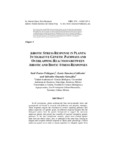
Please use this identifier to cite or link to this item:
http://ricaxcan.uaz.edu.mx/jspui/handle/20.500.11845/622| Title: | Abiotic stress response in plants: integrative genetic pathways and overlapping reactions between abiotic and biotic stress responses |
| Authors: | Fraire Velázquez, Saúl Sánchez Calderón, Lenin Guzmán González, Salvador |
| Issue Date: | Jan-2012 |
| Publisher: | Nova Science Publishers, Inc |
| Abstract: | In all ecosystems, plants continuously face environmental stress and consequently are forced to respond with defensive and adaptive strategies. These responses require the activation of several signaling pathways that induce expression of specific genes. An effective response requires that the biological system have the genetic background to support the necessary molecular players that permit the assembly of essential integrative genetic pathways. In the most complicated scenario, plants must contend against more than one abiotic stress, pest, or pathogen at the same time, forcing an integral and complete defense response to adjust plant physiology. Certain molecular players act as hubs or master regulators to integrate signals from The exclusive license for this PDF is limited to personal website use only. No part of this digital document may be reproduced, stored in a retrieval system or transmitted commercially in any form or by any means. The publisher has taken reasonable care in the preparation of this digital document, but makes no expressed or implied warranty of any kind and assumes no responsibility for any errors or omissions. No liability is assumed for incidental or consequential damages in connection with or arising out of information contained herein. This digital document is sold with the clear understanding that the publisher is not engaged in rendering legal, medical or any other professional services. Saúl Fraire-Velázquez, Lenin Sánchez-Calderón et al. 134 different regulatory pathways activated by two or more types of abiotic stress or forms of biotic stress. Some defense and adaptive genes are transcriptionally regulated not only by a specific abiotic stress but also by biotic stress, exposing the existence of overlapping pathways. The genes shared between these networks appear to allow plants to prioritize their responses and ensure their survival by using their resources efficiently. The well-documented shared or convergence points in the response to abiotic and biotic stress in plants exhibit a superimposed complexity, as exemplified by induction of certain defense genes by biotic stress in presence only of a specific environmental condition (temperature and humidity). Interestingly, accumulating data strongly support the hypothesis that the convergence points between abiotic and biotic stress pathways also modulate the post-embryonic developmental program which is one of the most conspicuous adaptive strategies to cope with environmental stress. Pathogen attack or abiotic stresses such as nutrient scarcity alter cell division and cell differentiation processes, and consequently the plant architecture is modified. Plant growth regulators, such as auxins, cytokinins, ethylene, and jamonic acid, as well as reactive oxygen species, play crucial roles in the early steps of the convergence between these multiple stress signals. The advancement in powerful molecular tools, including transcriptome and proteome analysis, whole-genome sequencing, and bioinformatic studies are enabling disection of networks in abiotic and biotic signaling cascades and identification of the overlapping reactions and key factors that fulfill very important roles as integrative signals in plants. |
| URI: | http://hdl.handle.net/20.500.11845/622 https://doi.org/10.48779/swbw-7x87 |
| ISBN: | 978-1- 61942-197-4 |
| Other Identifiers: | info:eu-repo/semantics/publishedVersion |
| Appears in Collections: | *Documentos Académicos*-- UA Ciencias Biológicas |
Files in This Item:
| File | Description | Size | Format | |
|---|---|---|---|---|
| Abiotic stress resp in plants_Nova Science.pdf | 592,68 kB | Adobe PDF |  View/Open |
This item is licensed under a Creative Commons License
